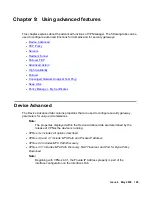
Resilient Tunnel
Issue 4 May 2005
213
Figure 67: Primary and Resilient Tunnels
Tunnel Switching
The switching mechanism involves time and a packet called a Heartbeat.
Figure 68
illustrates
how tunnels are switched.
Figure 68: Tunnel Switching
Explanation for
Figure 68
1. VSU
A
listens to VSU
B
’s heartbeat. The heartbeat has a configurable period called a
Heartbeat Interval.
2. If VSU
A
realizes a dead heartbeat, it asks VSU
B
for a heartbeat.
3. The number of times that VSU
A
can make a request is configurable, and is called the
Heartbeat Retry Limit.
4. If the number of requests exceeds the Heartbeat Retry Limit, VSU
A
then begins to establish
a connection with VSU
C
.
5. Since VSU
C
uses a low-speed connection, VSU
A
must anticipate a delayed response from
VSU
C
. That delay is called Hold-up Time, and is configurable with VPNmanager Console.
VSU
WAN
LAN
LAN
Resilient Tunnels are used for backing-up Primary Tunnels.
Should a Primary Tunnel go out of service, the Resilient
Tunnel will automatically be used for VPN traffic.
VSU
VSU
HUB
Router
Primary Tunnel
Resilient Tunnel
Router
Router
Low-speed
High-speed
Tokyo LAN
San Francisco LAN
A
VSU
A
WAN
LAN
LAN
VSU
C
VSU
B
HUB
Router
Router
Router
Low-speed
High-speed
Primary
End-point
Secondary
End-point
Control End-point:
tunnel switching is
controlled here.
1
2
5
6
3
4
Содержание 3.7
Страница 1: ...VPNmanager Configuration Guide Release 3 7 670 100 600 Issue 4 May 2005...
Страница 4: ......
Страница 20: ...Preface 20 Avaya VPNmanager Configuration Guide Release 3 7...
Страница 32: ...Overview of implementation 32 Avaya VPNmanager Configuration Guide Release 3 7...
Страница 53: ...Preferences Issue 4 May 2005 53 Figure 16 Tunnel End Point Policy...
Страница 54: ...Using VPNmanager 54 Avaya VPNmanager Configuration Guide Release 3 7...
Страница 244: ...Using advanced features 244 Avaya VPNmanager Configuration Guide Release 3 7...
Страница 292: ...Upgrading firmware and licenses 292 Avaya VPNmanager Configuration Guide Release 3 7...
















































